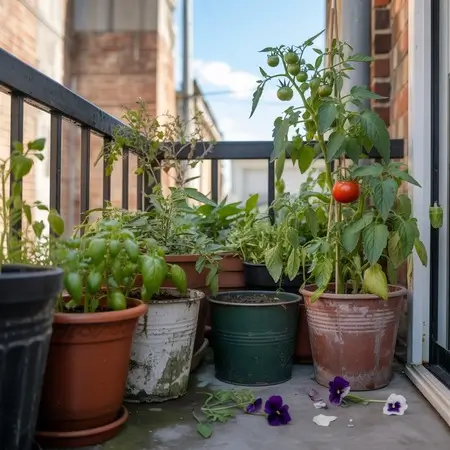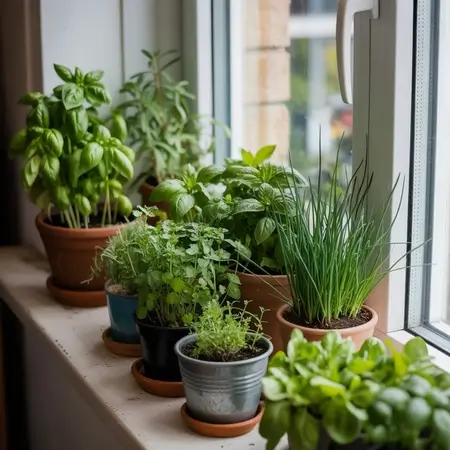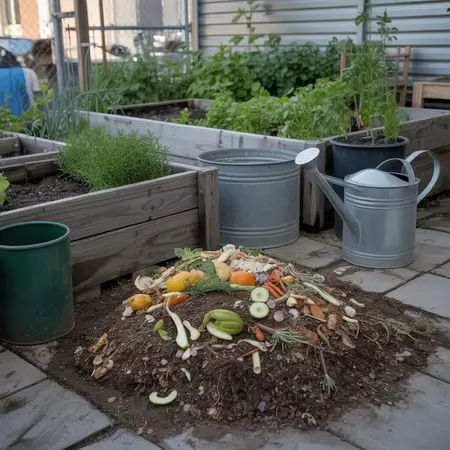9 Practical Urban Gardening Ideas for City Living
Urban gardening is all about growing plants in the middle of busy city life. When space is tight, you can still grow food, herbs, and even small fruit trees in smart ways.
You don’t need a big backyard or a farm. A balcony, rooftop, or even a sunny window can turn into a little garden.
The best part? You get fresh food, a green view, and the joy of growing something yourself. It’s simple, doable, and anyone can start.
1. Balcony Container Garden
If you have a small balcony, you can still grow plenty of plants. Use pots, buckets, or even recycled containers to grow vegetables, herbs, or flowers.

Tomatoes, peppers, and basil do well in containers and don’t take much space. The key is to choose containers with good drainage and place them where they get enough sunlight.
Even a few plants can give you fresh food and brighten up your living space. It’s one of the easiest ways to start urban gardening when space is tight.
2. Rooftop Garden
Flat rooftops are often wasted space, but they can become great food-growing spots. By using raised beds, large pots, or containers, you can grow vegetables, fruits, and herbs right above your head.
Rooftop gardens are especially useful in cities with little yard space. They also help reduce heat, provide fresh food, and give you a peaceful escape.
Just make sure the roof is strong enough and consider lightweight soil mixes. A rooftop garden can turn a plain roof into a productive mini farm.
3. Vertical Gardening
When you don’t have much ground space, think upward. Vertical gardening is all about using walls, shelves, or trellises to grow plants.
You can grow climbing beans, cucumbers, or even small leafy greens in vertical setups. Wall-mounted planters or stacked shelves make use of empty space and keep plants within easy reach.
This method is great for balconies, patios, or even indoor walls. It saves space and makes gardening possible even in the smallest urban homes.
4. Community Garden Plots
Not everyone has space at home, but many cities offer community garden plots. These are shared spaces where people come together to grow food.
You get a small plot to grow what you like while sharing tools and tips with others. It’s not just about gardening but also about building connections.
Community gardens are a great way to learn, share harvests, and enjoy fresh produce even if you don’t have your own land. They bring greenery into neighborhoods and encourage teamwork.
5. Windowsill Gardening
A sunny windowsill is enough to grow fresh herbs and small greens. You only need a few small pots and some soil.

Herbs like basil, mint, parsley, and chives grow well on windowsills. Leafy greens such as lettuce or spinach can also thrive there.
This type of gardening works well for people who don’t have outdoor space at all. It’s simple, affordable, and adds freshness to your meals. Having plants by the window also makes your home feel more alive and green.
6. Hanging Gardens
Hanging baskets are an excellent way to grow plants when floor space is limited. You can hang them on balconies, porches, or even near windows.
Strawberries, cherry tomatoes, and herbs like thyme or oregano do well in hanging baskets. They don’t take up space on the ground and still give you a steady harvest.
Hanging gardens are practical, easy to set up, and keep plants safe from pests that crawl on the ground. It’s a smart way to garden in tight spaces.
7. Microgreens Indoors
Microgreens are small, edible plants that grow fast and pack a lot of nutrients. You can grow them indoors in shallow trays with soil or a growing mat.
Popular choices include broccoli, radish, mustard greens, and sunflower shoots. They grow in just one to two weeks, making them perfect for quick harvests.
Microgreens don’t need much space or sunlight, so they’re great for apartments. You can place trays on a counter, shelf, or windowsill and enjoy fresh greens any time.
8. Raised Bed Urban Garden
Raised beds are a smart choice for small yards, rooftops, or even paved areas. They are wooden or metal boxes filled with soil, which makes planting and harvesting easier.
Raised beds help you control soil quality, improve drainage, and reduce weeds. You can grow vegetables like carrots, lettuce, and beans in them.
They also make gardening more comfortable since you don’t have to bend as much. If you have a bit of outdoor space, raised beds can turn it into a productive food garden.
9. Community Compost + Garden Combo
Urban gardening works best when you recycle what you already have. Collecting kitchen scraps like fruit peels, coffee grounds, and veggie waste lets you create compost.

This compost becomes food for your plants and reduces waste going to landfills. Some community gardens set up composting systems that everyone can use.
It’s a cycle where waste turns into healthy soil, and that soil grows fresh food. By joining or starting a composting project, you make your garden more sustainable and productive.
Final Thoughts
Urban gardening proves that you don’t need a big yard to grow your own food. With a balcony, rooftop, window, or even just a tray on your kitchen counter, you can start small and still enjoy fresh harvests.
Each idea is flexible, so you can pick what fits your space and lifestyle. The main thing is to just start, even one pot of herbs counts. Over time, you’ll learn, grow more, and find joy in turning city spaces into green, productive spots.
